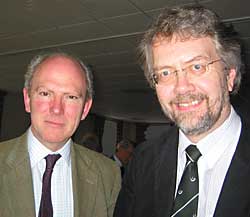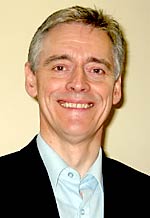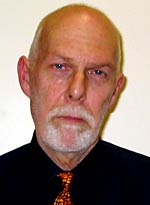Events and excursions, Winter 2007/08
The Myles Thoroton Hildyard Lecture
 |
Robert Hildyard with the Thoroton Society Chairman, John Beckett. |
Council decided in 2007 that one of the annual lecture series should commemorate our late and long serving president, Myles Thoroton Hildyard, who died in 2005. Myles left the Society a small sum of money, and the interest is to be used to pay a fee for the lecture.
The first Myles Thoroton Hildyard lecture was given by Nigel Lowey on 9 February (see report below). Although the subject was St Pancras station, there was a connection – one of the architects unsuccessful in the competition to build the Midland Hotel at St Pancras was T C Hine, who was, of course, the architect of Myles’s house, Flintham Hall.
Myles’s nephew Robert Hildyard, who now lives at Flintham Hall, attended the lecture and spoke a few words about Myles and about the house. He said how pleased he and his sister Marianna were that the Society, which was always close to Myles’s heart, should commemorate him in this manner. Robert said he hoped to join the Society, and to forge closer links through a future summer visit to Flintham. The President thanked him for his kind remarks. Robert Hildyard also confirmed that Myles was christened ‘Miles’, but at some stage adopted the spelling ‘Myles’. We agreed that from now on, it would be Myles! John Beckett
9 February 2008 – The Myles Thoroton Hildyard Lecture – Nigel Lowey, ‘St Pancras’
 |
Nigel Lowey |
Nigel Lowey [pictured left] is not a historian, but he is an excellent speaker! Anyone who knows or uses St Pancras Station will have appreciated this tour through the history of Barlow’s Shed from the 1860s when the station was first developed, to the renovations of the last few years which have turned it into the Eurostar Terminus as ‘St Pancras International’. On the way we had a guided excursion through the magnificent Sir George Gilbert Scott hotel, sadly vandalised by the tasteless (in every way) employees of the unlamented British Rail, who eventually caused such damage and decay that the building had to be abandoned in 1985. It is due to become apartments and a luxury hotel, probably in 2010. St Pancras is a local station for East Midlanders, with the bricks made in Mapperley, and the ironwork by the Butterley Company at Ripley. It has served the East Midlands ever since, but with High Speed 1 (2 hours 10 mins to Paris) leaving from one side of the station, and East Midlands Trains and First Capital Connect from the other, it is now an international terminus we must share. Thank goodness for John Betjeman, who led the successful campaign to save St Pancras (when it was threatened in the wake of the demolition of Euston), and for William Barlow, whose ingenuity made the project possible on the site available; and to the railway politics of the 1860s which made a new station next to King’s Cross necessary. John Beckett
Saturday 8 December 2007 – ‘Young Lawrence’ by John Worthen
 |
John Worthen |
Professor John Worthen [pictured right] of the University of
Nottingham's D H Lawrence Research Centre, and editor and biographer
of Lawrence, began his Christmas lecture by explaining the significance
of the date. The first appearance in print of a work by D H Lawrence was
on 7 December 1907. A short story, ‘The Prelude’, won its category
in the Nottingham Guardian Christmas competition;
it was submitted on his behalf by Lawrence's childhood friend Jessie Chambers.
Professor Worthen provided a fascinating account of Lawrence's early development as a writer during his student years in Nottingham and his period as a teacher in Croydon. The aspiring author read voraciously and experimented with a wide variety of literary genres, drawing on the style and technique of established authors. He consciously distanced himself from his Eastwood identity and Eastwood's mining culture. When his novel The Trespasser was published (1912), Lawrence received favourable critical attention for his accomplished literary imagery. From this point, however, his writing changed. Prompted by Hueffer, the editor of English Review, he turned to his Midlands working class background for inspiration and developed his own voice, encouraged soon by the influence of his German wife Frieda. Although in later years Lawrence himself rewrote his early literary history, portraying himself as just a collier's son, a more complex picture was drawn by Professor Worthen who speculated that Lawrence's pre-1912 writing would not in itself have given him lasting fame. The talk prompted a lively discussion, including questions about Lawrence's links with Nottingham High School. Dorothy Johnston
Saturday 12 January 2008 – The Nora Witham Lecture:‘Picture the Past’ by Nick Tomlinson
The lecture on this occasion was given by Nick Tomlinson, the Project
Manager of 'Picture the Past'. The presentation was an interesting change
from the Society's usual style of lecture, in that it concentrated on the
technology involved in preserving, digitizing, and storing photographic
images, slides, negatives, postcards and other records of the past, which
had been taken in
and around Nottinghamshire, Derbyshire, and the cities of Nottingham and
Derby. The project was begun some six years ago, since when over 67,000
scanned photographs have been collated and catalogued. The project received
a grant from the Heritage Lottery Fund for the first three years, but is
now dependent upon the continued good will of the two counties and cities.
Nick gave members ample evidence of the scope and complexity of the project, which was no doubt understandable technology to some of the attenders, but which opened the eyes of many others. His presentation was given in an easily absorbed way, and the meeting was kept alert throughout, amazed by the skill of the work involved. The 'Picture the Past' website was launched in 2003, and it now attracts some 10,000 visitors each month from all over the world - evidence of the interest and value it has created. Nick concluded his lecture by giving members easily understood instructions for accessing the website themselves. Clearly, judging by the questions asked, the information created much interest among the members present. Alan Langton